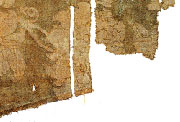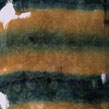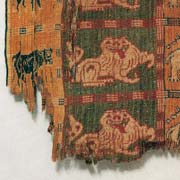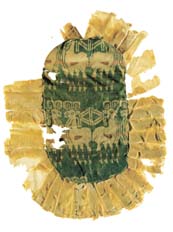|
|
|
|
|
|
|
|
|
|
|
|
|
|
|
|
|
|
|
|
|
|
|
|
|
|
|
|
|
 |
 |
 |
|
 |
 |
|
|
|
|
|
|
|
|
|
|
|
|
 |
 |
|
|
|
CHAPTER 3 |
|
|
|
|
|
|
|
|
|
 |
 |
|
|
|
 |
|
|
|
|
|
|
|
|
|
|
|
|
|
|
|
|
|
|
|
|
|
03.02g Grapes
03.02n (late 7th - early 8th century) |
|
|
|
|
|
|
|
|
|
|
|
|
|
|
|
|
|
|
|
|
|
|
 |
|
|
|
|
|
|
|
|
|
3/1 twill on 1/1, tie-dyed
Repeat: warp 3.5cm; weft 5cm;
Excavated from Reshui, Dulan, Qinghai
Qinghai Institute of Archaeology, Xining
(DRM1P2:S113-1)
|
|
 |
|
|
|
|
|
THE BOOK |
|
|
|
|
|
|
|
|
|
|
|
|
|
|
|
|
|
|
|
|
|
|
|
|
AUTHOR |
|
|
|
|
|
|
|
|
|
|
|
|
|
|
|
|
|
 |
|
|
|
|
|
|
|
|
|
|
|
|
|
|
|
|
|
|
|
|
|
|
|
|
|
|
|
|
|
|
|
|
|
|
|
|
|
|
|
|
|
CONTENTS |
|
|
|
|
|
|
|
|
|
|
|
|
|
|
|
|
|
|
|
|
|
|
|
|
|
|
|
|
|
The grape pattern was introduced into northwestern China in the third century, and was used as decorative motif on textiles. Wool and silk textiles of Eastern Han dynasty bearing the grape pattern have been found in the Xinjiang area. By the Tang dynasty, it was a common motif for textiles. Archaeological examples are also abundant.
This item has a grid of confronted S-frames formed by grapevines, and bunches of grapes fill the spaces. Scrolling vines are included to provide variety. The effect of continuous scrolls of vine is achieved with a relatively small repeat. The textile is dyed into alternating stripes of green and white by the tie-dyeing method.
Note: Xu & Zhao, 1991
|
|
|
|
|
|
|
|
|
|
|
|
|
|
|
|
|
|
|
|
|
|
|
|
|
|
ORDER |
|
|
|
|
|
|
|
|
|
|
|
|
|
|
|
|
|
|
|
|
|
|
|
|
|
|
|
|
|
|
|
|
|
|
CONTACT |
|
|
|
|
|
|
|
|
|
|
|
|
|
|
|
|
|
|
|
|
|
|
|
|
|
|
|
|
|
|
|
|
|
LINKS |
|
|
|
|
|
|
|
|
|
|
|
|
|
|
|
|
|
|
|
|
|
|
|
|
|
|
|
|
|
|
|
|
|
|
|
|
|
|
|
|
|
|
|
|
|
|
 |
|
03.00a Jin-silk with animal motifs, Turfan, 6th century |
|
|
|
|
|
|
|
|
|
|
|
|
|
|
|
|
|
|
|
|
|
|
|
|
|
 |
|
03.00b Taquete silk with goats, Turfan, 6th century |
|
|
|
|
|
|




